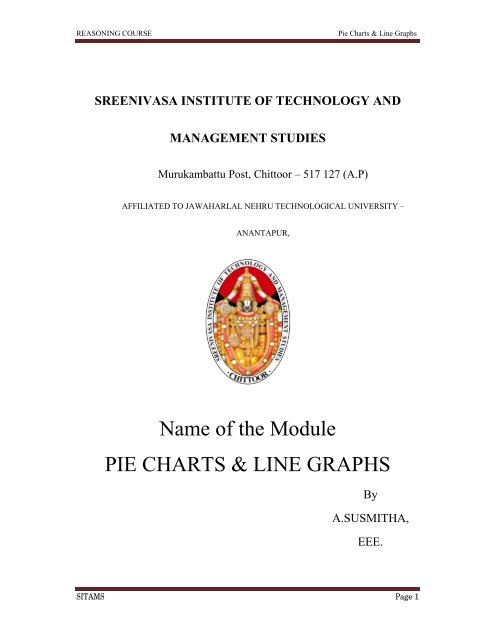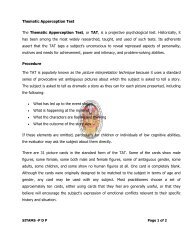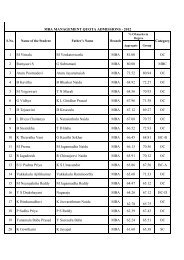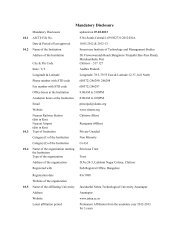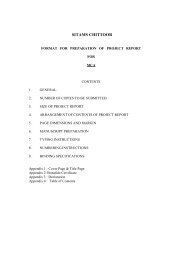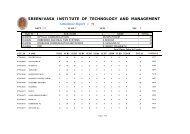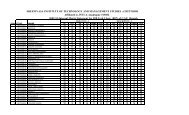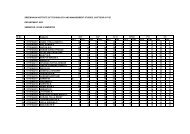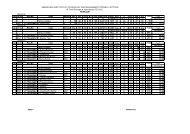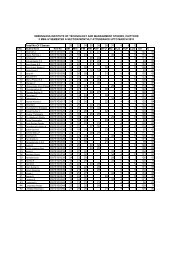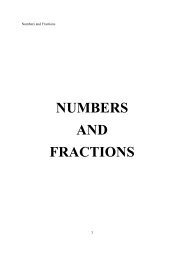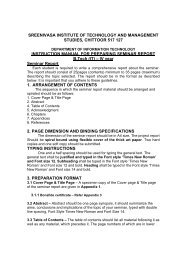Name of the Module PIE CHARTS & LINE GRAPHS - Sreenivasa ...
Name of the Module PIE CHARTS & LINE GRAPHS - Sreenivasa ...
Name of the Module PIE CHARTS & LINE GRAPHS - Sreenivasa ...
- No tags were found...
Create successful ePaper yourself
Turn your PDF publications into a flip-book with our unique Google optimized e-Paper software.
REASONING COURSEPie Charts & Line GraphsSREENIVASA INSTITUTE OF TECHNOLOGY ANDMANAGEMENT STUDIESMurukambattu Post, Chittoor – 517 127 (A.P)AFFILIATED TO JAWAHARLAL NEHRU TECHNOLOGICAL UNIVERSITY –ANANTAPUR,<strong>Name</strong> <strong>of</strong> <strong>the</strong> <strong>Module</strong><strong>PIE</strong> <strong>CHARTS</strong> & <strong>LINE</strong> <strong>GRAPHS</strong>ByA.SUSMITHA,EEE.SITAMS Page 1
REASONING COURSEPie Charts & Line GraphsMODULE OBJECTIVE:Pie charts:A pie chart (or a circle graph) is a circular chart divided into sectors, illustratingproportion. In a pie chart, <strong>the</strong> arc length <strong>of</strong> each sector (and consequently its centralangle and area), is proportional to <strong>the</strong> quantity it represents. When angles are measured with1 turn as unit <strong>the</strong>n a number <strong>of</strong> percent is identified with <strong>the</strong> same number <strong>of</strong> centiturns.Toge<strong>the</strong>r, <strong>the</strong> sectors create a full disk. It is named for its resemblance to a pie which hasbeen sliced. The earliest known pie chart is generally credited to William Playfair's StatisticalBreviary <strong>of</strong> 1801. Pie charts are common in business and journalism.Line graphs:A line graph is a way <strong>of</strong> visually representing related data where individual items <strong>of</strong> dataare plotted and joined by a line. They are useful for presenting data over time to comparechanges to a variable over set period. Joining up <strong>the</strong> points gives an instant picture <strong>of</strong> pasttrends (increases or decreases) and can be used to extrapolate those trends to makepredictions for future. The variable represented is continuous. A graph is set within 2 axes: x and y.The axes will not always start measuring from zero. If <strong>the</strong>y don’t this is called <strong>the</strong>suppression <strong>of</strong> zero. This will affect <strong>the</strong> appearance <strong>of</strong> <strong>the</strong> line(s) on <strong>the</strong> graph making <strong>the</strong>msteeper than <strong>the</strong>y would be if <strong>the</strong> scale started at zero and occupied <strong>the</strong> same space as <strong>the</strong>scale would be smaller.PREREQUISITES (RELATED FORMULAS):In pie charts, from geometry, we know that <strong>the</strong> area <strong>the</strong> sector <strong>of</strong> a circle must beproportional to <strong>the</strong> corresponding value <strong>of</strong> <strong>the</strong> component.Since <strong>the</strong> sum <strong>of</strong> all <strong>the</strong> central angle is 360°, we haveCentral angle <strong>of</strong> <strong>the</strong> component = {(value <strong>of</strong> <strong>the</strong> component/Total value) x 360} °.SITAMS Page 2
REASONING COURSEPie Charts & Line GraphsSOLVED EXAMPLES:<strong>PIE</strong> <strong>CHARTS</strong>:Example 1-5:The following pie-charts show <strong>the</strong> distribution <strong>of</strong> students <strong>of</strong> graduate and post-graduatelevels in seven different institutes in a town. [Bank P.O. 2003]1. What is <strong>the</strong> total number <strong>of</strong> graduate and post-graduate level students is institute R?A. 8320 B. 7916C. 9116 D. 8099Answer: (D)Required number = (17% <strong>of</strong> 27300) + (14% <strong>of</strong> 24700)= 4641 + 3458= 8099.2. What is <strong>the</strong> ratio between <strong>the</strong> number <strong>of</strong> students studying at post-graduate and graduatelevels respectively from institute S?A. 14:19 B. 19:21C. 17:21 D. 19:14Answer: (D)Required ratio = (21% <strong>of</strong> 24700) = (21 x 24700) = 19(14% <strong>of</strong> 27300) 14 x 27300 143. How many students <strong>of</strong> institutes <strong>of</strong> M and S are studying at graduate level?A. 7516 B. 8463C. 9127 D. 9404Answer: (B)Students <strong>of</strong> institute M at graduate level= 17% <strong>of</strong> 27300 = 4641.Students <strong>of</strong> institute S at graduate level = 14% <strong>of</strong> 27300 = 3822.Total number <strong>of</strong> students at graduate in institutes M and S = (4641 + 3822)= 8463.SITAMS Page 3
REASONING COURSEPie Charts & Line Graphs4. What is <strong>the</strong> ratio between <strong>the</strong> number <strong>of</strong> students studying at post-graduate level frominstitutes S and <strong>the</strong> number <strong>of</strong> students studying at graduate level from institute Q?A. 13:19 B. 21:13C. 13:8 D. 19:13Answer: (D)Required ratio = (21% <strong>of</strong> 24700) = (21 x 24700) = 19 .(13% <strong>of</strong> 27300) 13 x 27300 135. Total number <strong>of</strong> students studying at post-graduate level from institutes N and P isA. 5601 B. 5944C. 6669 D. 8372Answer: (C)Required number = (15% <strong>of</strong> 24700) + (12% <strong>of</strong> 24700)= 3705 + 2964= 6669.Example 6-8:The following pie charts exhibit <strong>the</strong> distribution <strong>of</strong> <strong>the</strong> overseas tourist traffic from India. Thetwo charts show <strong>the</strong> tourist distribution by country and <strong>the</strong> age pr<strong>of</strong>iles <strong>of</strong> <strong>the</strong> touristsrespectively. [NABARD, 2001]Distribution <strong>of</strong> Overseas Tourist Traffic from India.6. What percentage <strong>of</strong> Indian tourist went to ei<strong>the</strong>r USA or UK?A.40 % B.50 %C.60 % D.70 %Answer: (B)SITAMS Page 4
REASONING COURSEPie Charts & Line Graphs(40+10) = 50% (from first chart)7. The ratio <strong>of</strong> <strong>the</strong> number <strong>of</strong> Indian tourists that went to USA to <strong>the</strong> number <strong>of</strong> Indiantourists who were below 30 years <strong>of</strong> age is ?A.2:1B.8:3C.3:8D. cannot be determinedAnswer: (B)40:15 = 8:38. If amongst o<strong>the</strong>r countries, Switzerland accounted for 25% <strong>of</strong> <strong>the</strong> Indian tourist traffic, andit is known from <strong>of</strong>ficial Swiss records that a total <strong>of</strong> 25 lakh Indian tourists had gone toSwitzerland during <strong>the</strong> year, <strong>the</strong>n find <strong>the</strong> number <strong>of</strong> 30-39 year old Indian tourists who wentabroad in that year ?A. Rs.18.75 lakh B. Rs. 25 lakhC. Rs. 50 lakh D. Rs. 75 lakhAnswer: (D)Tourist traffic from o<strong>the</strong>r countries to Swiz is 20%.Amongst this 20%, 25% <strong>of</strong> traffic from India.So, 25% <strong>of</strong> 20% = 5% corresponds to <strong>the</strong> Indian traffic in Switzerland.5 % corresponds to Switzerland's 25 lakh. Hence 15% will be 75 lakh.<strong>LINE</strong> <strong>GRAPHS</strong>:Example 9-13Two different finance companies declare fixed annual rate <strong>of</strong> interest on <strong>the</strong> amounts investedwith <strong>the</strong>m by investors. The rate <strong>of</strong> interest <strong>of</strong>fered by <strong>the</strong>se companies may differ from yearto year depending on <strong>the</strong> variation in <strong>the</strong> economy <strong>of</strong> <strong>the</strong> country and <strong>the</strong> banks rate <strong>of</strong>interest. The annual rate <strong>of</strong> interest <strong>of</strong>fered by <strong>the</strong> two Companies P and Q over <strong>the</strong> years isshown by <strong>the</strong> line graph provided below. [Bank P.O. 2003]Annual Rate <strong>of</strong> Interest Offered by Two Finance Companies Over <strong>the</strong> Years.9. A sum <strong>of</strong> Rs. 4.75 lakhs was invested in Company Q in 1999 for one year. How muchmore interest would have been earned if <strong>the</strong> sum was invested in Company P?A.Rs 19,000 B.Rs.14, 250C.Rs.11, 750 D.Rs. 9,500Answer: (D)DIFFERENCE = Rs. [(10% <strong>of</strong> 4.75) - (8% <strong>of</strong> 4.75)]= Rs. (2% <strong>of</strong> 4.75) lakhs= Rs. 0.095 lakhs= Rs. 9500.10. If two different amounts in <strong>the</strong> ratio 8:9 are invested in Companies P and Q respectivelyin 2002, <strong>the</strong>n <strong>the</strong> amounts received after one year as interests from Companies P and Q arerespectively in <strong>the</strong> ratio?SITAMS Page 5
REASONING COURSEPie Charts & Line GraphsA.2:3 B. 3:4C.6:7 D. 4:3Answer: (D)Let <strong>the</strong> amounts invested in 2002 in Companies P and Q be Rs. 8x and Rs. 9xrespectively.Then, interest received after one year= Rs. (6% <strong>of</strong> 8x)from Company P=Rs. 48 x.100and interest received after one year fromCompany Q= Rs. (4% <strong>of</strong> 9x)=Rs. 36 x.100Required ratio =48 x10036 x100= 4 .311. In 2000, a part <strong>of</strong> Rs. 30 lakhs was invested in Company P and <strong>the</strong> rest was invested inCompany Q for one year. The total interest received was Rs. 2.43 lakhs. What was <strong>the</strong>amount invested in Company P?A. Rs.9 lakh B. Rs.11 lakhC.Rs. 12 lakhD.Rs.18 lakhAnswer: (D)Let Rs. x lakhs be invested in Company P in 2000, <strong>the</strong> amount invested in Company Q in2000 = Rs. (30 - x) lakhs.Total interest received from <strong>the</strong> two Companies after 1 year= Rs. [(7.5% <strong>of</strong> x) + {9% <strong>of</strong> (30 - x)}] lakhs1.5x= Rs. 2.7 - lakhs.1001.5x2.7 - = 2.43 x = 18.10012. An investor invested a sum <strong>of</strong> Rs. 12 lakhs in Company P in 1998. The total amountreceived after one year was re-invested in <strong>the</strong> same Company for one more year. The totalappreciation received by <strong>the</strong> investor on his investment was?A. Rs. 2, 96,200 B. Rs. 2, 42,200C. Rs. 2, 25,600 D. Rs. 2, 16,000Answer: (C)Amount received from Company P after one year (i.e., in 199) on investing Rs. 12 lakhs in it= Rs. [12 + (8% <strong>of</strong> 12)] lakhs= Rs. 12.96 lakhs.Appreciation received on investment during <strong>the</strong> period <strong>of</strong> two years= Rs. (14.256 - 12) lakhs= Rs. 2.256 lakhs = Rs. 2, 25,600.SITAMS Page 6
REASONING COURSEPie Charts & Line Graphs13. An investor invested Rs. 5 lakhs in Company Q in 1996. After one year, <strong>the</strong> entireamount along with <strong>the</strong> interest was transferred as investment to Company P in 1997 for oneyear. What amount will be received from Company P, by <strong>the</strong> investor?A. Rs. 5, 94,550 B. Rs. 5, 80,425C. Rs. 5, 77,800 D. Rs. 5, 77,500Answer: (B)Amount received from Company Q after one year on investment <strong>of</strong> Rs. 5 lakhs in <strong>the</strong> year1996= Rs. [5 + (6.5% <strong>of</strong> 5)] lakhs= Rs. 5.325 lakhs.Amount received from Company P after one year on investment <strong>of</strong> Rs. 5.325 lakhs in <strong>the</strong>year 1997= Rs. [5.325 + (9% <strong>of</strong> 5.325)] lakhs= Rs. 5.80425 lakhs= Rs. 5, 80, 425.Example: 14-19The following line graph gives <strong>the</strong> annual percent pr<strong>of</strong>it earned by a Company during <strong>the</strong>period 1995 - 2000. [R.B.I. 2003]Percent Pr<strong>of</strong>it Earned by a Company over <strong>the</strong> Years.%Pr<strong>of</strong>it = Income - Expenditure x 100Expenditure14. If <strong>the</strong> expenditures in 1996 and 1999 are equal, <strong>the</strong>n <strong>the</strong> approximate ratio <strong>of</strong> <strong>the</strong> incomein 1996 and 1999 respectively is?A.1:1 B. 2:3C.13:14 D. 9:10Answer: (D)Let <strong>the</strong> expenditure in 1996 = x.Also, let <strong>the</strong> incomes in 1996 and 1999 be I1 and I2 respectively.Then, for <strong>the</strong> year 1996, we have:55 = I 1 - x x 10055 =I 1- 1 I1 = 155x ... (i)x 100 x 10070 = I 2 - x 70 I 2x 100 = - 1 I2 = 170x ... (ii)x 100 x 100From (i) and (ii), we get:155xI1 =I2100170x100= 155 0.91 9 : 10.170 1SITAMS Page 7
REASONING COURSEPie Charts & Line Graphs15. If <strong>the</strong> income in 1998 was Rs. 264 crores, what was <strong>the</strong> expenditure in 1998?A. Rs. 104 crores B. Rs. 145 croresC. Rs. 160 crores D. Rs. 185 croresAnswer: (C)Let <strong>the</strong> expenditure is 1998 be Rs. x crores.Then, 65 = 264 - x x 100x65 264 = - 1100 xx = 264 x 100 = 160.165Expenditure in 1998 = Rs. 160 crores.16. In which year is <strong>the</strong> expenditure minimum?A. 2000 B. 1997C. 1996 D. Cannot be determinedAnswer: (D)The line-graph gives <strong>the</strong> comparison <strong>of</strong> percent pr<strong>of</strong>it for different years.But <strong>the</strong> comparison <strong>of</strong> <strong>the</strong> expenditures is not possible without more data.Therefore, <strong>the</strong> year with minimum expenditure cannot be determined.17. If <strong>the</strong> pr<strong>of</strong>it in 1999 was Rs. 4 crores, what was <strong>the</strong> pr<strong>of</strong>it in 2000?A. Rs. 4.2 crores B. Rs. 6.2 croresC. Rs. 6.8 crores D. Cannot be determinedAnswer: (D)From <strong>the</strong> line-graph we obtain information about <strong>the</strong> percentage pr<strong>of</strong>it only. To find <strong>the</strong> pr<strong>of</strong>itin 2000 we must have <strong>the</strong> data for <strong>the</strong> income or expenditure in 2000.Therefore, <strong>the</strong> pr<strong>of</strong>it for 2000 cannot be determined.18. What is <strong>the</strong> average pr<strong>of</strong>it earned for <strong>the</strong> given years?A. 50 2/3 B. 55 5/6C. 60 1/6 D. 33 5/3Answer: (B)Average percent pr<strong>of</strong>it earned for <strong>the</strong> given years= 1 x [40 + 55 + 45 + 65 + 70 + 60] = 335 = 55 5 .6 6 6SITAMS Page 8
REASONING COURSEPie Charts & Line GraphsEXERCISE PROBLEMS:<strong>PIE</strong> <strong>CHARTS</strong>:Problem 1-3:The following pie chart gives <strong>the</strong> information about <strong>the</strong> distribution <strong>of</strong> weight in <strong>the</strong> humanbody according to different kinds <strong>of</strong> components. Study <strong>the</strong> pie charts and answer <strong>the</strong>question.Distribution <strong>of</strong> Weight in Human Body1. What percentage <strong>of</strong> proteins <strong>of</strong> <strong>the</strong> human body is equivalent to <strong>the</strong> weight <strong>of</strong> its skin?A. 41.66 % B. 43.33 %C. 44.44% D. Cannot be determined2. How much <strong>of</strong> <strong>the</strong> human body is nei<strong>the</strong>r made <strong>of</strong> bones or skin?A. 40 % B. 50 %C. 60 % D. 70 %3. What is <strong>the</strong> ratio <strong>of</strong> <strong>the</strong> distribution <strong>of</strong> proteins in <strong>the</strong> muscles to that <strong>of</strong> <strong>the</strong> distribution <strong>of</strong>proteins in <strong>the</strong> bones?A. 2:1 B. 2:3C. 3:2 D. Cannot be determinedProblem 4-6:The pie chart shows <strong>the</strong> distribution <strong>of</strong> New York market share by value <strong>of</strong> differentcomputer companies in 2005.SITAMS Page 9
REASONING COURSEPie Charts & Line GraphsThe pie chart shows <strong>the</strong> distribution <strong>of</strong> New York market share by volume <strong>of</strong> differentcomputer companies in 2005.Number <strong>of</strong> units sold in 2005 in New York = 1,500Value <strong>of</strong> units sold in 2005 in New York = US $1,650,000.Distribution <strong>of</strong> New York market share by volume <strong>of</strong> different computer companies in 2005.4. For <strong>the</strong> year 2005, which company has realised <strong>the</strong> lowest average unit sales price for aPC?A. Commodore B. IBMC. Tandy D. Cannot be determined5. Over <strong>the</strong> period 2005-2006, if sales (value-wise) <strong>of</strong> IBM PC's increased by 50% and <strong>of</strong>Apple by 15% assuming that PC sales <strong>of</strong> all o<strong>the</strong>r computer companies remained <strong>the</strong> same,by what percentage (approximately) would <strong>the</strong> PC sales in New York (value -wise) increaseover <strong>the</strong> same period ?A. 16.1 % B. 18%C. 14 % D. None <strong>of</strong> <strong>the</strong>se6. In 2005, <strong>the</strong> average unit sale price <strong>of</strong> an IBM PC was approximately (in US$)A. 3180 B. 2800C. 393 D. 3080Problem 7-11:The following pie-chart shows <strong>the</strong> sources <strong>of</strong> funds to be collected by <strong>the</strong> National HighwaysAuthority <strong>of</strong> India (NHAI) for its Phase II projects. Study <strong>the</strong> pie -chart and answers <strong>the</strong>question that follow.SITAMS Page 10
REASONING COURSEPie Charts & Line GraphsSources <strong>of</strong> funds to be arranged by NHAI for Phase II projects (in Rs.crores)7. Nearly about 20% <strong>of</strong> <strong>the</strong> funds are to be arranged through:A. SPVS B. External AssistanceC. Annuity D. Market Borrowing8. If NHAI could receive a total <strong>of</strong> Rs. 9695 crores as External Assistance, by what percent(approximately) should it increase <strong>the</strong> Market Borrowing to arrange for <strong>the</strong> shortage <strong>of</strong>funds?A. 4.5 % B. 7.5 %C. 6 % D. 8 %9. If <strong>the</strong> toll is to be collected through an outsourced agency by allowing a maximum 10%commission, how much amount should be permitted to be collected by <strong>the</strong> outsourcedagency, so that <strong>the</strong> project is supported with Rs. 4910 crores?A. Rs. 6213 crores B. Rs. 5827 croresC. Rs. 5401 crores D. Rs. 5316 crores10. The central angle corresponding to Market Borrowing isA. 52° B. 137.8°C. 187.2° D. 192.4°11. The approximate ratio <strong>of</strong> <strong>the</strong> funds to be arranged through Toll and that through MarketBorrowing isA. 2:1 B. 1:6C. 3:11 D. 2:5Problem 12-15:The circle-graph given here shows <strong>the</strong> spending <strong>of</strong> a country on various sports during aparticular year. Study <strong>the</strong> graph carefully and answer <strong>the</strong> questions given below it.SITAMS Page 11
REASONING COURSEPie Charts & Line Graphs12. What percent <strong>of</strong> total spending is spent on Tennis?A.12 ½ % B.22 ½ %C.25%D.45%13. How much percent more is spent on Hockey than that on Golf?A.27 % B.37 %C.37.5 % D.75 %14. If <strong>the</strong> total amount spent on sports during <strong>the</strong> year be Rs. 1,80,00,000 , <strong>the</strong> amount spenton Basketball exceeds on Tennis by:A. Rs. 2, 50,000 B. Rs. 3, 60,000C.Rs.3, 75,000 D. Rs. 4, 10,00015. How much percent less is spent on Football than that on Cricket?A. 22 2/9 % B.27 %C.33 1/3 % D.37 1/7 %Problem 16-25:The following pie-chart shows <strong>the</strong> percentage distribution <strong>of</strong> <strong>the</strong> expenditure incurred inpublishing a book. Study <strong>the</strong> pie-chart and <strong>the</strong> answer <strong>the</strong> questions based on it.[Bank P.O. 2002]Various Expenditures (in percentage) Incurred in Publishing a Book16. If for a certain quantity <strong>of</strong> books, <strong>the</strong> publisher has to pay Rs. 30,600 as printing cost, and<strong>the</strong>n what will be amount <strong>of</strong> royalty to be paid for <strong>the</strong>se books?A. Rs. 19, 450 B. Rs. 21, 200C. Rs. 22, 950 D. Rs. 26, 15017. What is <strong>the</strong> central angle <strong>of</strong> <strong>the</strong> sector corresponding to <strong>the</strong> expenditure incurred onRoyalty ?A. 15° B. 24°C. 54° D. 48°18. The price <strong>of</strong> <strong>the</strong> book is marked 20% above <strong>the</strong> C.P. If <strong>the</strong> marked price <strong>of</strong> <strong>the</strong> book is RsA. Rs. 36 B. Rs. 37.5C. Rs. 42 D. Rs. 44.2519. If 5500 copies are published and <strong>the</strong> transportation cost on <strong>the</strong>m amounts to Rs. 82500,<strong>the</strong>n what should be <strong>the</strong> selling price <strong>of</strong> <strong>the</strong> book so that <strong>the</strong> publisher can earn a pr<strong>of</strong>it <strong>of</strong>25%?A. Rs. 187.50 B. Rs. 191.5C. Rs. 175 D. Rs. 18020. Royalty on <strong>the</strong> book is less than <strong>the</strong> printing cost by:A. 5% B. 33 1/5 %C.20 % D. 25 %SITAMS Page 12
REASONING COURSEPie Charts & Line Graphs21. If <strong>the</strong> difference between <strong>the</strong> two expenditures is represented by 18º in <strong>the</strong> pie-chart, <strong>the</strong>n<strong>the</strong>se expenditures possibly areA. Binding Cost and Promotion CostB. Paper Cost and RoyaltyC. Binding Cost and Printing CostD. Paper Cost and Printing Cost22. For an edition <strong>of</strong> 12,500 copies, <strong>the</strong> amount <strong>of</strong> Royalty paid by <strong>the</strong> publisher is Rs. 2,81,250. What should be <strong>the</strong> selling price <strong>of</strong> <strong>the</strong> book if <strong>the</strong> publisher desires a pr<strong>of</strong>it <strong>of</strong> 5%?A. Rs. 152.50 B. Rs. 157.50C. Rs. 162.50 D. Rs. 167.5023. If for an edition <strong>of</strong> <strong>the</strong> book, <strong>the</strong> cost <strong>of</strong> paper is Rs. 56250, <strong>the</strong>n find <strong>the</strong> promotion costfor this edition.A. Rs. 20, 000 B. Rs. 22, 500C. Rs. 25, 500 D. Rs. 28, 12524. Which two expenditures toge<strong>the</strong>r have central angle <strong>of</strong> 108º?A. Binding Cost and Transportation CostB. Printing cost and Paper CostC. Royalty and Promotion CostD. Binding Cost and Paper Cost25. What is <strong>the</strong> central angle <strong>of</strong> <strong>the</strong> sector corresponding to <strong>the</strong> expenditure incurred onprinting cost?A. 15° B. 24°C. 54° D.36°<strong>LINE</strong> <strong>GRAPHS</strong>:Problem 26-30: Study <strong>the</strong> following line graph and answer <strong>the</strong> questions. [S.B.I. P.O.2000]Exports from Three Companies over <strong>the</strong> Years (in Rs. crore)26. For which <strong>of</strong> <strong>the</strong> following pairs <strong>of</strong> years <strong>the</strong> total exports from <strong>the</strong> three Companiestoge<strong>the</strong>r are equal?A. 1995 and 1998 B. 1996 and 1998C. 1997 and 1998 D. 1995 and 199627. Average annual exports during <strong>the</strong> given period for Company Y is approximately whatpercent <strong>of</strong> <strong>the</strong> average annual exports for Company Z?A. 87.12 % B. 89.64 %C.91.21 % D. 93.33 %SITAMS Page 13
REASONING COURSEPie Charts & Line Graphs28. In which year was <strong>the</strong> difference between <strong>the</strong> exports from Companies X and Y <strong>the</strong>minimum?A. 1994 B. 1995C. 1996 D. 199729. What was <strong>the</strong> difference between <strong>the</strong> average exports <strong>of</strong> <strong>the</strong> three Companies in 1993 and<strong>the</strong> average exports in 1998?A. Rs. 15.33 crores B. Rs. 18.67 croresC. Rs. 20 crores D. Rs. 22.17 crores30. In how many <strong>of</strong> <strong>the</strong> given years, were <strong>the</strong> exports from Company Z more than <strong>the</strong> averageannual exports over <strong>the</strong> given years?A. 2 B. 3C. 4 D. 5Problem 31-35:The following line graph gives <strong>the</strong> ratio <strong>of</strong> <strong>the</strong> amounts <strong>of</strong> imports by a company to <strong>the</strong>amount <strong>of</strong> exports from that company over <strong>the</strong> period from 1995 to 2001. [S.B.I. P.O. 2001]Ratio <strong>of</strong> Value <strong>of</strong> Imports to Exports by a Company over <strong>the</strong> Years.31. If <strong>the</strong> imports in 1998 were Rs. 250 crores and <strong>the</strong> total exports in <strong>the</strong> years 1998 and1999 toge<strong>the</strong>r was Rs. 500 crores, <strong>the</strong>n <strong>the</strong> imports in 1999 was?A. Rs. 250 crores B. Rs. 300 croresC. Rs. 357 crores D. Rs. 420 crores32. The imports were minimum proportionate to <strong>the</strong> exports <strong>of</strong> <strong>the</strong> company in <strong>the</strong> year ?A. 1995 B. 1996C. 1997 D. 200033. What was <strong>the</strong> percentage increase in imports from 1997 to 1998?A. 72 B. 56C. 28 D. Data inadequate34. If <strong>the</strong> imports <strong>of</strong> <strong>the</strong> company in 1996 was Rs. 272 crores, <strong>the</strong> exports from <strong>the</strong> companyin 1996 was?A. Rs. 370 crores B. Rs. 320 croresC. Rs. 280 crores D. Rs. 275 crores35. In how many <strong>of</strong> <strong>the</strong> given years were <strong>the</strong> exports more than <strong>the</strong> imports?A. 1 B. 2C. 3 D. 4SITAMS Page 14
REASONING COURSEPie Charts & Line GraphsProblem 36-40:Study <strong>the</strong> following line graph and answer <strong>the</strong> questions based on it. [R.B.I. 2003]Number <strong>of</strong> Vehicles Manufactured by Two companies over <strong>the</strong> Years(Number in Thousands)36. What is <strong>the</strong> difference between <strong>the</strong> number <strong>of</strong> vehicles manufactured by Company Y in2000 and 2001?A. 50, 000 B. 42, 000C. 33, 000 D. 21, 00037. What is <strong>the</strong> difference between <strong>the</strong> total productions <strong>of</strong> <strong>the</strong> two Companies in <strong>the</strong> givenyears ?A. 19, 000 B. 22, 000C. 26, 000 D. 28, 00038. What is <strong>the</strong> average numbers <strong>of</strong> vehicles manufactured by Company X over <strong>the</strong> givenperiod? (Rounded <strong>of</strong>f to nearest integer)A. 1, 19, 333 B. 1, 13, 666C. 1, 12, 778 D. 1, 11, 22339. In which <strong>of</strong> <strong>the</strong> following years, <strong>the</strong> difference between <strong>the</strong> productions <strong>of</strong> Companies Xand Y was <strong>the</strong> maximum among <strong>the</strong> given years?A. 1997 B. 1998C. 1999 D. 200040. The production <strong>of</strong> Company Y in 2000 was approximately what percent <strong>of</strong> <strong>the</strong> production<strong>of</strong> Company X in <strong>the</strong> same year?A. 173 B. 164C. 132 D. 97Problem 41-45The following line graph gives <strong>the</strong> percent pr<strong>of</strong>it earned by two Companies X and Y during<strong>the</strong> period 1996 - 2001. [NABARD, 2002]Percentage pr<strong>of</strong>it earned by Two Companies X and Y over <strong>the</strong> Given Years%Pr<strong>of</strong>it = Income - Expenditure x 100ExpenditureSITAMS Page 15
REASONING COURSEPie Charts & Line Graphs41. The incomes <strong>of</strong> two Companies X and Y in 2000 were in <strong>the</strong> ratio <strong>of</strong> 3:4 respectively.What was <strong>the</strong> respective ratio <strong>of</strong> <strong>the</strong>ir expenditures in 2000?A. 7:22 B. 14:19C. 15:22 D. 27:3542. If <strong>the</strong> expenditure <strong>of</strong> Company Y in 1997 was Rs. 220 crores, what was its income in1997?A. Rs. 312 crores B. Rs. 297 croresC. Rs. 283 crores D. Rs. 275 crores43. If <strong>the</strong> expenditures <strong>of</strong> Company X and Y in 1996 were equal and <strong>the</strong> total income <strong>of</strong> <strong>the</strong>two Companies in 1996 was Rs. 342 crores, what was <strong>the</strong> total pr<strong>of</strong>it <strong>of</strong> <strong>the</strong> two Companiestoge<strong>the</strong>r in 1996? (Pr<strong>of</strong>it = Income - Expenditure)A. Rs. 240 crores B. Rs. 171 croresC. Rs. 120 crores D. Rs. 102 crores44. The expenditure <strong>of</strong> Company X in <strong>the</strong> year 1998 was Rs. 200 crores and <strong>the</strong> income <strong>of</strong>company X in 1998 was <strong>the</strong> same as its expenditure in 2001. The income <strong>of</strong> Company X in2001 was?A. Rs. 465 crores B. Rs. 385 croresC. Rs. 335 crores D. Rs. 295 crores45. If <strong>the</strong> incomes <strong>of</strong> two Companies were equal in 1999, <strong>the</strong>n what was <strong>the</strong> ratio <strong>of</strong>expenditure <strong>of</strong> Company X to that <strong>of</strong> Company Y in 1999?A. 6:5 B. 5:6C. 11:6 D. 16:15Problem 46-50The following line graph gives <strong>the</strong> percentage <strong>of</strong> <strong>the</strong> number <strong>of</strong> candidates who qualified anexamination out <strong>of</strong> <strong>the</strong> total number <strong>of</strong> candidates who appeared for <strong>the</strong> examination over aperiod <strong>of</strong> seven years from 1994 to 2000.[Bank P.O. 2000]Percentage <strong>of</strong> Candidates Qualified to Appeared in an Examination over<strong>the</strong> YearsSITAMS Page 16
REASONING COURSEPie Charts & Line Graphs46. The difference between <strong>the</strong> percentages <strong>of</strong> candidates qualified to appear was maximumin which <strong>of</strong> <strong>the</strong> following pairs <strong>of</strong> years?A. 1994 and 1995 B. 1997 and 1998C. 1998 and 1999 D. 1999 and 200047. In which pair <strong>of</strong> years was <strong>the</strong> number <strong>of</strong> candidates qualified <strong>the</strong> same?A. 1995 and 1997 B. 1995 and 2000C. 1998 and 1999 D. Data inadequate48. If <strong>the</strong> number <strong>of</strong> candidates qualified in 1998 was 21200, what was <strong>the</strong> number <strong>of</strong>candidates appeared in 1998?A. 32, 000 B. 28, 500C. 26, 500 D. 25, 00049. If <strong>the</strong> total number <strong>of</strong> candidates appeared in 1996 and 1997 toge<strong>the</strong>r was 47400, <strong>the</strong>n <strong>the</strong>total number <strong>of</strong> candidates qualified in <strong>the</strong>se two years toge<strong>the</strong>r was?A. 34, 700 B. 32, 100C. 31, 500 D. Data inadequate50. The total number <strong>of</strong> candidates qualified in 1999 and 2000 toge<strong>the</strong>r was 33500 and <strong>the</strong>number <strong>of</strong> candidates appeared in 1999 was 26500. What was <strong>the</strong> number <strong>of</strong> candidates in2000?A. 24, 500 B. 22, 000C. 20, 500 D. 19, 000SITAMS Page 17
REASONING COURSEPie Charts & Line GraphsSolutions for exercise problems:1. Answer: (A)Total percentage = (10 / 24) x 100 = 41.6666667 %2. Answer: (D)20 + 10 = 30% is made up <strong>of</strong> ei<strong>the</strong>r bones or skin. Hence, 70% is made up <strong>of</strong> nei<strong>the</strong>r.3. Answer: (D)It cannot be determined since <strong>the</strong> respective distributions are not known.4. Answer: (D)Although it seems to be Commodore, <strong>the</strong> answer cannot be determined due to <strong>the</strong> fact that weare unaware <strong>of</strong> <strong>the</strong> break-up <strong>of</strong> <strong>the</strong> sales value and volume <strong>of</strong> companies compromising <strong>the</strong>o<strong>the</strong>r categories.5. Answer: (A)If we assume <strong>the</strong> total sales to be 100 in <strong>the</strong> first year, IBM's sales would go up by 50% (from28 to 42) contributing an increase <strong>of</strong> 14 to <strong>the</strong> total sales value.Similarly, Apple's increase <strong>of</strong> 15% would contribute an increase <strong>of</strong> 2.1 to <strong>the</strong> total salesvalue. The net change would be 14 + 2.1 on 100. (i.e., 16.1%)6. Answer: (D)IBM accounts for 28% <strong>of</strong> <strong>the</strong> share by value and 10% <strong>of</strong> <strong>the</strong> share by volume.28% <strong>of</strong> 1650000 = 28 x 1650000/100 = 46200010% <strong>of</strong> 1500 = 10 x 1500/100 = 150Therefore, average unit sale price = 462000/150 = 3080.7. Answer: (B)20% <strong>of</strong> <strong>the</strong> total funds to be arranged = Rs. (20% <strong>of</strong> 57600) crores= Rs. 11520 croresRs. 11486 crores.Rs. 11486 crores is <strong>the</strong> amount <strong>of</strong> funds to be arranged through External Assistance.8. Answer: (C)Shortage <strong>of</strong> funds arranged = Rs. (11486 - 9695) croresthrough External Assistance= Rs. 1791 crores.Increase required in Market Borrowing = Rs. 1791 crores.1791Percentage increase required = x 100 % = 5.98% 6%.299529. Answer: (C)Amount permitted10. Answer: (C)= (Funds required from Toll for projects <strong>of</strong> Phase II) + (10% <strong>of</strong><strong>the</strong>se funds)= Rs. 4910 crores + Rs. (10% <strong>of</strong> 4910) crores= Rs. (4910 + 491) crores= Rs. 5401 crores.Central angle corresponding to Market Borrowing = 29952 x 360º = 187.2º5760011. Answer: (B)Required ratio = 4910 = 1 1 .29952 6.1 612. Answer: (A)Percentage <strong>of</strong> money spend on Tennis =45 x 100 % = 121360 2SITAMS Page 18
REASONING COURSEPie Charts & Line Graphs13. Answer: (D)Let <strong>the</strong> total spending on sports be Rs. x. Then,36 xAmount spent on Golf = Rs. x x = Rs. .360 1063 7xAmount spent on Hockey = Rs x x = Rs. .360 407x xDifference = Rs. - = Rs 3x .40 10 40Required percentage = Rs.3x/40x 100 % = 75%.x/1014. Answer: (A)Amount spent on Basketball exceeds that on Tennis by:Rs. [ (50 - 45) x 1,80,00,000] = Rs. 2, 50,000.36015. Answer: (C)Let <strong>the</strong> total spending on sports be Rs. x. Then,81 9x x x = Rs. .Amount spent on Cricket = Rs. 360 4054 3xAmount spent on Football = Rs x x = Rs. .360 209x 3xDifference = Rs. - = Rs 3x .40 20 403x/40Required percentage = Rs.x 100 % = 33 1 %.9x/40 316. Answer: (C)Let <strong>the</strong> amount <strong>of</strong> Royalty to be paid for <strong>the</strong>se books be Rs. r.30600 x 15Then, 20 : 15 = 30600 : r r = Rs.= Rs. 22,950.2017. Answer: (C)Central angle corresponding to Royalty = (15% <strong>of</strong> 360)º=15 x 360º100= 54º.18. Answer: (B)Clearly, marked price <strong>of</strong> <strong>the</strong> book = 120% <strong>of</strong> C.P.Also, cost <strong>of</strong> paper = 25% <strong>of</strong> C.PLet <strong>the</strong> cost <strong>of</strong> paper for a single book be Rs. n.Then, 120 : 25 = 180 : nn = Rs.25 x 180 = Rs. 37.50 .12019. Answer: (A)For <strong>the</strong> publisher to earn a pr<strong>of</strong>it <strong>of</strong> 25%, S.P. = 125% <strong>of</strong> C.P.Also Transportation Cost = 10% <strong>of</strong> C.P.SITAMS Page 19
REASONING COURSEPie Charts & Line GraphsLet <strong>the</strong> S.P. <strong>of</strong> 5500 books be Rs. x.Then, 10 : 125 = 82500 : xx = Rs.125 x 8250010= Rs. 1031250.S.P. <strong>of</strong> one book = Rs.10312505500= Rs. 187.50 .20. Answer: (D)Printing Cost <strong>of</strong> book = 20% <strong>of</strong> C.P.Royalty on book = 15% <strong>of</strong> C.P.Difference = (20% <strong>of</strong> C.P.) - (15% <strong>of</strong> C.P) = 5% <strong>of</strong> C.P.Percentage difference =DifferencePrintingCostx100 %21. Answer: (D)Central angle <strong>of</strong> 18º 18 x100 % <strong>of</strong> <strong>the</strong> total expenditure= 360= 5% <strong>of</strong> <strong>the</strong> total expenditure.From <strong>the</strong> given chart it is clear that:=5% <strong>of</strong> C.P.PrintingCostOut <strong>of</strong> <strong>the</strong> given combinations, only in combination (d) <strong>the</strong> difference is 5% i.e.Paper Cost - Printing Cost = (25% - 20%) <strong>of</strong> <strong>the</strong> total expenditure= 5% <strong>of</strong> <strong>the</strong> total expenditure.22. Answer: (B)Clearly, S.P. <strong>of</strong> <strong>the</strong> book = 105% <strong>of</strong> C.P.Clearly, S.P. <strong>of</strong> <strong>the</strong> book = 105% <strong>of</strong> C.P.Then, 15 : 105 = 281250 : xx = Rs.105 x 281250 = Rs. 1968750.15x100 % = 25%.S.P. <strong>of</strong> one book = Rs.1968750 = Rs. 157.50 .1250023. Answer: (B)Let <strong>the</strong> Promotion Cost for this edition be Rs. p.Then, 25 : 10 = 56250 : p24. Answer: (A)Central angle <strong>of</strong> 108º == 30% <strong>of</strong> <strong>the</strong> total expenditure.From <strong>the</strong> pie chart it is clear that:Binding Cost + Transportation Costp = Rs.56250 x 10 = Rs. 22,500.25108 x 100 % <strong>of</strong> <strong>the</strong> total expenditure360= (20% + 10%) <strong>of</strong> <strong>the</strong> total expenditure= 30% <strong>of</strong> <strong>the</strong> total expenditure.Binding Cost and Transportation Cost toge<strong>the</strong>r have a central angle <strong>of</strong> 108º.SITAMS Page 20
REASONING COURSEPie Charts & Line Graphs25. Answer: (D)Central angle corresponding to Royalty = (10% <strong>of</strong> 360)º=10 x 360º100= 36º.26. Answer: (D)Total exports <strong>of</strong> <strong>the</strong> three Companies X, Y and Z toge<strong>the</strong>r, during various years are:In 1993 = Rs. (30 + 80 + 60) crores = Rs. 170 crores.In 1994 = Rs. (60 + 40 + 90) crores = Rs. 190 crores.In 1995 = Rs. (40 + 60 + 120) crores = Rs. 220 crores.In 1996 = Rs. (70 + 60 + 90) crores = Rs. 220 crores.In 1997 = Rs. (100 + 80 + 60) crores = Rs. 240 crores.In 1998 = Rs. (50 + 100 + 80) crores = Rs. 230 crores.In 1999 = Rs. (120 + 140 + 100) crores = Rs. 360 crores.Clearly, <strong>the</strong> total exports <strong>of</strong> <strong>the</strong> three Companies X, Y and Z toge<strong>the</strong>r are same during <strong>the</strong>years 1995 and 1996.27. Answer: (D)1. The amount <strong>of</strong> exports <strong>of</strong> Company X (in crore Rs.) in <strong>the</strong> years 1993, 1994, 1995,1996, 1997, 1998 and 1999 are 30, 60, 40, 70, 100, 50 and 120 respectively.2. The amount <strong>of</strong> exports <strong>of</strong> Company Y (in crore Rs.) in <strong>the</strong> years 1993, 1994, 1995,1996, 1997, 1998 and 1999 are 80, 40, 60, 60, 80, 100 and 140 respectively.3. The amount <strong>of</strong> exports <strong>of</strong> Company Z (in crore Rs.) in <strong>the</strong> years 1993, 1994, 1995,1996, 1997, 1998 and 1999 are 60, 90,, 120, 90, 60, 80 and 100 respectively.Average annual exports (in Rs. crore) <strong>of</strong> Company Y during <strong>the</strong> given period= 1 x (80 + 40 + 60 + 60 + 80 + 100 + 140) = 560 = 80.7 7Average annual exports (in Rs. crore) <strong>of</strong> Company Z during <strong>the</strong> given period= 1 x (60 + 90 + 120 + 90 + 60 + 80 + 100) = 600 .7 780Required percentage =600x 100 % 93.33%.728. Answer: (C)The difference between <strong>the</strong> exports from <strong>the</strong> Companies X and Y during <strong>the</strong> various yearsare:In 1993 = Rs. (80 - 30) crores = Rs. 50 crores.In 1994 = Rs. (60 - 40) crores = Rs. 20 crores.In 1995 = Rs. (60 - 40) crores = Rs. 20 crores.In 1996 = Rs. (70 - 60) crores = Rs. 10 crores.In 1997 = Rs. (100 - 80) crores = Rs. 20 crores.In 1998 = Rs. (100 - 50) crores = Rs. 50 crores.In 1999 = Rs. (140 - 120) crores = Rs. 20 crores.Clearly, <strong>the</strong> difference is minimum in <strong>the</strong> year 1996.29. Answer: (C)Average exports <strong>of</strong> <strong>the</strong> three Companies X, Y and Z in 1993= Rs. 1 x (30 + 80 + 60) crores = Rs. 170 crores.SITAMS Page 21
REASONING COURSEPie Charts & Line Graphs3 3Average exports <strong>of</strong> <strong>the</strong> three Companies X, Y and Z in 19981 230= Rs. x (50 + 100 + 80) crores = Rs. crores.3 3230 170Difference = Rs. - crores3 3= Rs.60 crores3= Rs. 20 crores.30. Answer: (C)Average annual exports <strong>of</strong> Company Z during <strong>the</strong> given period= 1 x (60 + 90 + 120 + 90 + 60 + 80 + 100)7600= Rs. crores7= Rs. 85.71 crores.From <strong>the</strong> analysis <strong>of</strong> graph <strong>the</strong> exports <strong>of</strong> Company Z are more than <strong>the</strong> average annualexports <strong>of</strong> Company Z (i.e., Rs. 85.71 crores) during <strong>the</strong> years 1994, 1995, 1996 and 1999,i.e., during 4 <strong>of</strong> <strong>the</strong> given years.31. Answer: (D)The ratio <strong>of</strong> imports to exports for <strong>the</strong> years 1998 and 1999 are 1.25 and 1.40 respectively.Let <strong>the</strong> exports in <strong>the</strong> year 1998 = Rs. x crores.Then, <strong>the</strong> exports in <strong>the</strong> year 1999 = Rs. (500 - x) crores.1.25 = 250 x = 250 = 200 [Using ratio for 1998]x 1.25Thus, <strong>the</strong> exports in <strong>the</strong> year 1999 = Rs. (500 - 200) crores = Rs. 300 crores.Let <strong>the</strong> imports in <strong>the</strong> year 1999 = Rs. y crores.Then, 1.40 = y y = (300 x 1.40) = 420.300Imports in <strong>the</strong> year 1999 = Rs. 420 crores.32. Answer: (C)The imports are minimum proportionate to <strong>the</strong> exports implies that <strong>the</strong> ratio <strong>of</strong> <strong>the</strong> value <strong>of</strong>imports to exports has <strong>the</strong> minimum value.Now, this ratio has a minimum value 0.35 in 1997, i.e., <strong>the</strong> imports are minimumproportionate to <strong>the</strong> exports in 1997.33. Answer: (D)The graph gives only <strong>the</strong> ratio <strong>of</strong> imports to exports for different years. To find <strong>the</strong>percentage increase in imports from 1997 to 1998, we require more details such as <strong>the</strong> value<strong>of</strong> imports or exports during <strong>the</strong>se years.Hence, <strong>the</strong> data is inadequate to answer this question.34. Answer: (B)Ratio <strong>of</strong> imports to exports in <strong>the</strong> year 1996 = 0.85.Let <strong>the</strong> exports in 1996 = Rs. x crores.SITAMS Page 22
REASONING COURSEPie Charts & Line GraphsThen, 272 = 0.85 x = 272 = 320.x 0.85Exports in 1996 = Rs. 320 crores.35. Answer: (D)The exports are more than <strong>the</strong> imports imply that <strong>the</strong> ratio <strong>of</strong> value <strong>of</strong> imports to exports isless than 1.Now, this ratio is less than 1 in years 1995, 1996, 1997 and 2000.Thus, <strong>the</strong>re are four such years.36. Answer: (D)Required difference = (128000 - 107000) = 21000.37. Answer: (C)From <strong>the</strong> line-graph it is clear that <strong>the</strong> productions <strong>of</strong> Company X in <strong>the</strong> years 1997, 1998,1999, 2000, 2001 and 2002 are 119000, 99000, 141000, 78000, 120000 and 159000 andthose <strong>of</strong> Company Y are 139000, 120000,100000, 128000, 107000 and 148000 respectively.Total production <strong>of</strong> Company X from 1997 to 2002= 119000 + 99000 + 141000 + 78000 + 120000 + 159000= 716000.and total production <strong>of</strong> Company Y from 1997 to 2002= 139000 + 120000 + 100000 + 128000 + 107000 + 148000= 742000.Difference = (742000 - 716000) = 26000.38. Answer: (A)Average number <strong>of</strong> vehicles manufactured by Company X= 1 x (119000 + 99000 + 141000 + 78000 + 120000 + 159000)6= 119333.39. Answer: (D)The difference between <strong>the</strong> productions <strong>of</strong> Companies X and Y in various years is:For 1997 (139000 - 119000) = 20000.For 1998 (120000 - 99000) = 21000.For 1999 (141000 - 100000) = 41000.For 2000 (128000 - 78000) = 50000.For 2001 (120000 - 107000) = 13000.For 2002 (159000 - 148000) = 11000.Clearly, maximum difference was in 2000.40. Answer: (B)Required percentage = 128000 x 100 % 164%.7800041. Answer: (C)Let <strong>the</strong> incomes in 2000 <strong>of</strong> Companies X and Y be 3x and 4x respectively.And let <strong>the</strong> expenditures in 2000 <strong>of</strong> Companies X and Y be E 1 and E 2 respectively.Then, for Company X we have:65 = 3x - E 1x 10065 =3x - 1 E1 = 3x x 100 .... (i)E 1 100 E 1 165For Company Y we have:50 = 4x - E 2x 10050 =4x - 1 E2 = 4x x 100 .... (ii)E 2 100 E 2 150SITAMS Page 23
REASONING COURSEPie Charts & Line GraphsFrom (i) and (ii), we get:3x x 100E 1 165 3 x 150 15 = = = (Required ratio).E 24x x 100 4 x 165 2215042. Answer: (B)Pr<strong>of</strong>it percent <strong>of</strong> Company Y in 1997 = 35.Let <strong>the</strong> income <strong>of</strong> Company Y in 1997 be Rs. x crores.Then, 35 = x - 220 x 100 x = 297.220Income <strong>of</strong> Company Y in 1997 = Rs. 297 crores.43. Answer: (D)Let <strong>the</strong> expenditures <strong>of</strong> each companies X and Y in 1996 be Rs. x crores.And let <strong>the</strong> income <strong>of</strong> Company X in 1996 be Rs. z crores.So that <strong>the</strong> income <strong>of</strong> Company Y in 1996 = Rs. (342 - z) crores.Then, for Company X we have:40 = z - x 40 z 100zx 100= - 1 x = .... (i)x 100 x 140Also, for Company Y we have:45 = (342 - z) 45 (342 - z) (342 - z) x 100x 100 = - 1 x = .... (ii)x 100 x 145From (i) and (ii), we get:100z (342 - z) x 100= z = 168.140 145Substituting z = 168 in (i), we get : x = 120.Total expenditure <strong>of</strong> Companies X and Y in 1996 = 2x = Rs. 240 crores.Total income <strong>of</strong> Companies X and Y in 1996 = Rs. 342 crores.Total pr<strong>of</strong>it = Rs. (342 - 240) crores = Rs. 102 crores.44. Answer: (A)Let <strong>the</strong> income <strong>of</strong> Company X in 1998 be Rs. x crores.Then, 55 = x - 200 x 100 x = 310.200Expenditure <strong>of</strong> Company X in 2001 = Income <strong>of</strong> Company X in 1998= Rs. 310 crores.Let <strong>the</strong> income <strong>of</strong> Company X in 2001 be Rs. z crores.Then, 50 = z - 310 x 100 z = 465.310Income <strong>of</strong> Company X in 2001 = Rs. 465 crores.45. Answer: (D)Let <strong>the</strong> incomes <strong>of</strong> each <strong>of</strong> <strong>the</strong> two Companies X and Y in 1999 be Rs. x.And let <strong>the</strong> expenditures <strong>of</strong> Companies X and Y in 1999 be E 1 and E 2 respectively.Then, for Company X we have:50 = x - E 1 50 xx 100 = - 1 x = 150 E 1 .... (i)E 1 100 E 1 100SITAMS Page 24
REASONING COURSEPie Charts & Line GraphsAlso, for Company Y we have:60 = x - E 2 60 xx 100 = - 1 x = 160 E 2 .... (ii)E 2 100 E 2 10046. Answer: (B)The differences between <strong>the</strong> percentages <strong>of</strong> candidates qualified to appeared for <strong>the</strong> give pairs<strong>of</strong> years are:For 1994 and 1995 = 50 - 30 = 20.For 1998 and 1999 = 80 - 80 = 0.For 1994 and 1997 = 50 - 30 = 20.For 1997 and 1998 = 80 - 50 = 30.For 1999 and 2000 = 80 - 60 = 20.Thus, <strong>the</strong> maximum difference is between <strong>the</strong> years 1997 and 1998.47. Answer: (D)The graph gives <strong>the</strong> data for <strong>the</strong> percentage <strong>of</strong> candidates qualified to appeared and unless <strong>the</strong>absolute values <strong>of</strong> number <strong>of</strong> candidates qualified or candidates appeared is know we cannotcompare <strong>the</strong> absolute values for any two years.Hence, <strong>the</strong> data is inadequate to solve this question.48. Answer: (C)The number <strong>of</strong> candidates appeared in 1998 be x.Then, 80% <strong>of</strong> x = 21200 x = 21200 x 100 = 26500 (required number).8049. Answer: (D)The total number <strong>of</strong> candidates qualified in 1996 and 1997 toge<strong>the</strong>r, cannot be determineduntil we know at least, <strong>the</strong> number <strong>of</strong> candidates appeared in any one <strong>of</strong> <strong>the</strong> two years 1996or 1997 or <strong>the</strong> percentage <strong>of</strong> candidates qualified to appeared in 1996 and 1997 toge<strong>the</strong>r.Hence, <strong>the</strong> data is inadequate.50. Answer: (C)The number <strong>of</strong> candidates qualified in 1999 = (80% <strong>of</strong> 26500) = 21200.Number <strong>of</strong> candidates qualified in 2000 = ( 33500 - 21200 ) = 12300.Let <strong>the</strong> number <strong>of</strong> candidates appeared in 2000 be x.Then, 60% <strong>of</strong> x = 12300 x = 12300 x 100 = 20500.60SITAMS Page 25
REASONING COURSEPie Charts & Line GraphsQUESTION BANK FOR MOCKTESTSITAMS Page 26
REASONING COURSEPie Charts & Line Graphs<strong>PIE</strong> <strong>CHARTS</strong>:QUESTION 1-4Study <strong>the</strong> following pie-chart and <strong>the</strong> table and answer <strong>the</strong> questions based on <strong>the</strong>m.Proportion <strong>of</strong> Population <strong>of</strong> Seven Villages in 1997Village% Population Below Poverty LineX 38Y 52Z 42R 51S 49T 46V 581. If <strong>the</strong> population <strong>of</strong> village R in 1997 is 32000, <strong>the</strong>n what will be <strong>the</strong> population <strong>of</strong> villageY below poverty line in that year?A. 14100 B. 15600C. 16500 D. 170002. The ratio <strong>of</strong> population <strong>of</strong> village T below poverty line to that <strong>of</strong> village Z below povertyline in 1997 is:A.11:23 B. 13:11C. 23:11 D. 11:133. Find <strong>the</strong> population <strong>of</strong> village S if <strong>the</strong> population <strong>of</strong> village X below poverty line in 1997 is12160.A. 18, 500 B. 20, 500C. 22, 000 D. 26, 0004. If in 1998, <strong>the</strong> population <strong>of</strong> villages Y and V increase by 10% each and <strong>the</strong> percentage <strong>of</strong>population below poverty line remains unchanged for all <strong>the</strong> villages, <strong>the</strong>n find <strong>the</strong> population<strong>of</strong> village V below poverty line in 1998, given that <strong>the</strong> population <strong>of</strong> village in 1997 was30000.A. 11, 250 B. 12, 760C. 13, 140 D. 13, 780QUESTION 5-10The following pie chart shows <strong>the</strong> amount <strong>of</strong> subscriptions generated for India Bonds fromdifferent categories <strong>of</strong> investors.SITAMS Page 27
REASONING COURSEPie Charts & Line GraphsSubscriptions Generated for India Bonds5. In <strong>the</strong> corporate sector, approximately how many degrees should be <strong>the</strong>re in <strong>the</strong> centralangle ?A. 120 B. 121C. 122 D. 1236. If <strong>the</strong> investment by NRI's are Rs 4,000 crore, <strong>the</strong>n <strong>the</strong> investments by corporate housesand FII's toge<strong>the</strong>r is:A. 24, 000 crore B. 24, 363 croreC. 25, 423 crore D. 25, 643 crore7. What percentage <strong>of</strong> <strong>the</strong> total investment is coming from FII's and NRI's ?A. 33 % B. 11 %C. 44 % D. 22 %8. If <strong>the</strong> total investment o<strong>the</strong>r than by FII and corporate houses is Rs 335,000 crore, <strong>the</strong>n <strong>the</strong>investment by NRI's and Offshore funds will be (approximately) ?A. 27, 4100 B. 28, 5600C. 29, 300 D. Cannot be determined9. If <strong>the</strong> total investment flows from FII's were to be doubled in <strong>the</strong> next year and <strong>the</strong>investment flows from all o<strong>the</strong>r sources had remained constant at <strong>the</strong>ir existing levels for thisyear, <strong>the</strong>n what would be <strong>the</strong> proportion <strong>of</strong> FII investment in <strong>the</strong> total investment into IndiaBonds next year (in US $ millions) ?A. 40 % B. 50 %C. 60 % D. 70 %10. What is <strong>the</strong> approximate ratio <strong>of</strong> investment flows into India Bonds from NRI's tocorporate houses?A.1:4 B. 1:3C. 3:1 D. cannot be determinedQUESTION 11-15Study <strong>the</strong> following pie-diagrams carefully and answer <strong>the</strong> questions given below it:Percentage Composition <strong>of</strong> Human BodySITAMS Page 28
REASONING COURSEPie Charts & Line Graphs11. What percent <strong>of</strong> <strong>the</strong> total weight <strong>of</strong> human body is equivalent to <strong>the</strong> weight <strong>of</strong> <strong>the</strong> proteinsin skin in human body?A. 0.016 % B. 1.6 %C. 0.16 % D. Data inadequate12. What will be <strong>the</strong> quantity <strong>of</strong> water in <strong>the</strong> body <strong>of</strong> a person weighing 50 kg?A. 25 Kg B. 35 KgC. 41 Kg D. 42.5 Kg13. What is <strong>the</strong> ratio <strong>of</strong> <strong>the</strong> distribution <strong>of</strong> proteins in <strong>the</strong> muscles to that <strong>of</strong> <strong>the</strong> distribution <strong>of</strong>proteins in <strong>the</strong> bones?A.1:18 B. 1:2C. 2:1 D. 18:114. To show <strong>the</strong> distribution <strong>of</strong> proteins and o<strong>the</strong>r dry elements in <strong>the</strong> human body, <strong>the</strong> arc <strong>of</strong><strong>the</strong> circle should subtend at <strong>the</strong> centre an angle <strong>of</strong>:A.54° B. 126°C. 108° D. 252°15. In <strong>the</strong> human body, what part is made <strong>of</strong> nei<strong>the</strong>r bones nor skin?A.1/40 B. 2/80C. 3/5 D. None <strong>of</strong> <strong>the</strong>seQUESTIONS 16-20Study <strong>the</strong> following graph and <strong>the</strong> table and answer <strong>the</strong> questions given below.Data <strong>of</strong> different states regarding population <strong>of</strong> states in <strong>the</strong> year 1998SITAMS Page 29
REASONING COURSEPie Charts & Line GraphsTotal population <strong>of</strong> <strong>the</strong> given States = 3276000.Sex and Literacy wise Population RatioStatesSexLiteracyM F Literate IlliterateA.P 5 3 2 7M.P 3 1 1 4Delhi 2 3 2 1Goa 3 5 3 2Bihar 3 4 4 1U.P. 3 2 7 2T.N. 3 4 9 416. What will be <strong>the</strong> percentage <strong>of</strong> total number <strong>of</strong> males in U.P., M.P. and Goa toge<strong>the</strong>r to<strong>the</strong> total population <strong>of</strong> all <strong>the</strong> given states?A. 25 % B. 27.5 %C. 28.5 % D. 31.5 %17. What was <strong>the</strong> total number <strong>of</strong> illiterate people in A.P. and M.P. in 1998?A. 8, 76, 040 B. 9, 32,170C. 9, 81, 550 D. 11, 61, 16018. What is <strong>the</strong> ratio <strong>of</strong> <strong>the</strong> number <strong>of</strong> females in T.N. to <strong>the</strong> number <strong>of</strong> females in Delhi?A.7:5 B. 9:7C. 13:11 D. 15:1419. What was <strong>the</strong> number <strong>of</strong> males in U.P. in <strong>the</strong> year 1998?A. 2, 54, 650 B. 2, 94,840C. 3, 21, 470 D. 3, 41, 20020. If in <strong>the</strong> year 1998, <strong>the</strong>re was an increase <strong>of</strong> 10% in <strong>the</strong> population <strong>of</strong> U.P. and 12% in <strong>the</strong>population <strong>of</strong> M.P. compared to <strong>the</strong> previous year, and <strong>the</strong>n what was <strong>the</strong> ratio <strong>of</strong> populations<strong>of</strong> U.P. and M.P. in 1997?A.42:55 B. 48:55C. 7:11 D. 4:5QUESTIONS 20-25The circle graph given here shows <strong>the</strong> spending <strong>of</strong> a country on various sports during aparticular year. Study <strong>the</strong> graph carefully and answer <strong>the</strong> questions given below it.SITAMS Page 30
REASONING COURSEPie Charts & Line Graphs1 Golf 36°2 Tennis 45°3 Basketball 50°4 Cricket 81°5 Hockey 63°6 Football 54°7 O<strong>the</strong>rs 31°21. What percent <strong>of</strong> <strong>the</strong> total spending is spent on Tennis?A. 12 1/2 % B. 22 1/2 %C. 45% D. 25 %22. How much percent more is spent on Hockey than that <strong>of</strong> Golf?A. 27 % B. 35 %C. 37.5 % D. 75 %23. How much percent less is spent on Football than that on Cricket?A. 22 2/9 % B. 27 %C. 37 1/2 % D. 33 1/3 %24. If <strong>the</strong> total amount spent on sports during <strong>the</strong> year was Rs. 2 crores, <strong>the</strong> amount spent onCricket and Hockey toge<strong>the</strong>r was:A. Rs. 8, 00, 000 B. Rs. 80, 00, 000C. Rs. 1, 20, 00, 000 D. Rs. 1, 60, 00, 00025. If <strong>the</strong> total amount spent on sports during <strong>the</strong> year be Rs. 1, 80, 00, 000, <strong>the</strong> amount spenton Basketball exceeds that on Tennis by:A. Rs. 82, 50, 000 B. Rs. 3, 60, 000C. Rs. 3, 75, 000 D. Rs. 4, 10, 000<strong>LINE</strong> <strong>GRAPHS</strong>:QUESTIONS 26-30Answer <strong>the</strong> questions based on <strong>the</strong> given line graph. [R.B.I. 2003]Ratio <strong>of</strong> Exports to Imports (in terms <strong>of</strong> money in Rs. crores) <strong>of</strong> Two Companies Over<strong>the</strong> Years26. In how many <strong>of</strong> <strong>the</strong> given years were <strong>the</strong> exports more than <strong>the</strong> imports for Company A?SITAMS Page 31
REASONING COURSEPie Charts & Line GraphsA. 2 B. 3C .4 D. 527. If <strong>the</strong> imports <strong>of</strong> Company A in 1997 were increased by 40 percent, what would be <strong>the</strong>ratio <strong>of</strong> exports to <strong>the</strong> increased imports?A. 1.20 B. 1.25C. 1.30 D. cannot be determined28. If <strong>the</strong> exports <strong>of</strong> Company A in 1998 were Rs. 237 crores, what was <strong>the</strong> amount <strong>of</strong>imports in that year?A. Rs. 189.6 crore B. Rs. 243 croreC. Rs. 281 crore D. Rs. 316 crore29. In 1995, <strong>the</strong> export <strong>of</strong> Company A was double that <strong>of</strong> Company B. If <strong>the</strong> imports <strong>of</strong>Company A during <strong>the</strong> year was Rs. 180 crores, what was <strong>the</strong> approximate amount <strong>of</strong> imports<strong>of</strong> Company B during that year?A. Rs. 190 crore B. Rs. 210 croreC. Rs. 225 crore D. Cannot be determined30. In which year(s) was <strong>the</strong> difference between impors and exports <strong>of</strong> Company B <strong>the</strong>maximum?A. 2000 B. 1996C. 1998 & 2000 D. Cannot be determinedQUESTIONS 31-35Study <strong>the</strong> following line graph which gives <strong>the</strong> number <strong>of</strong> students who joined and left <strong>the</strong>school in <strong>the</strong> beginning <strong>of</strong> year for six years, from 1996 to 2001. [S.B.I. P.O. 2001]Initial Strength <strong>of</strong> school in 1995 = 3000.31. The number <strong>of</strong> students studying in <strong>the</strong> school during 1999 was?A. 2950 B. 3000C. 3100 D. 315032. For which year, <strong>the</strong> percentage rise/fall in <strong>the</strong> number <strong>of</strong> students who left <strong>the</strong> schoolcompared to <strong>the</strong> previous year is maximum?A. 1997 B. 1998C. 1999 D. 2000SITAMS Page 32
REASONING COURSEPie Charts & Line Graphs33. The strength <strong>of</strong> school increased/decreased from 1997 to 1998 by approximately whatpercent?A. 1.2 % B. 1.7 %C. 2.1 % D. 2.4 %34. The number <strong>of</strong> students studying in <strong>the</strong> school in 1998 was what percent <strong>of</strong> <strong>the</strong> number <strong>of</strong>students studying in <strong>the</strong> school in 2001?A. 92.13 % B. 93.75 %C. 96.88 % D. 97.25 %35. The ratio <strong>of</strong> <strong>the</strong> least number <strong>of</strong> students who joined <strong>the</strong> school to <strong>the</strong> maximum number<strong>of</strong> students who left <strong>the</strong> school in any <strong>of</strong> <strong>the</strong> years during <strong>the</strong> given period is?A. 7:9 B. 4:5C. 3:4 D. 2:3QUESTIONS 36-40In a school <strong>the</strong> periodical examination are held every second month. In a session duringApril 2001 - March 2002, a student <strong>of</strong> Class IX appeared for each <strong>of</strong> <strong>the</strong> periodicalexams. The aggregate marks obtained by him in each periodical exam are represented in<strong>the</strong> line-graph given below. [S.B.I. P.O. 2003]Marks Obtained by student in Six Periodical Held in Every Two Months During<strong>the</strong> Year in <strong>the</strong> Session 2001 - 2002.Maximum Total Marks in each Periodical Exam = 50036. In which periodical exams did <strong>the</strong> student obtain <strong>the</strong> highest percentage increase in marksover <strong>the</strong> previous periodical exams?A. June, 01 B. August, 01C. Oct, 01 D. Dec, 0137. The total number <strong>of</strong> marks obtained in Feb. 02 is what percent <strong>of</strong> <strong>the</strong> total marks obtainedin April 01?A. 110 % B. 112.5 %C. 115 % D. 116.5 %38. What is <strong>the</strong> percentage <strong>of</strong> marks obtained by <strong>the</strong> student in <strong>the</strong> periodical exams <strong>of</strong>August, 01 and Oct, 01 taken toge<strong>the</strong>r?A. 73.25 % B. 75.5 %C. 77 % D. 78.75 %39. What are <strong>the</strong> average marks obtained by <strong>the</strong> student in all <strong>the</strong> periodical exams during <strong>the</strong>last session?A. 373 B. 379C. 381 D. 385SITAMS Page 33
REASONING COURSEPie Charts & Line Graphs40. In which periodical exams <strong>the</strong>re is a fall in percentage <strong>of</strong> marks as compared to <strong>the</strong>previous periodical exams?A. None B. June, 01C. Oct, 01 D. Feb, 02QUESTIONS 41-43:Velocity-time graphConsider <strong>the</strong> motion <strong>of</strong> <strong>the</strong> object whose velocity-time graph is given in <strong>the</strong> diagram.41. What is <strong>the</strong> acceleration <strong>of</strong> <strong>the</strong> object between times t=0 and t=2?A. 4 m/s² B. 6 m/s²C. -4 m/s² D. -6 m/s²42. What is <strong>the</strong> acceleration <strong>of</strong> <strong>the</strong> object between times t=0 and t=12?A. 2 m/s² B. -2 m/s²C. 4 m/s² D. -4 m/s²43. What is <strong>the</strong> net displacement <strong>of</strong> <strong>the</strong> object between times t=0 and t=16?A. 200m B. 400mC. 100m D. 50mQUESTIONS 44-50Study <strong>the</strong> following line graphs which gives <strong>the</strong> number <strong>of</strong> students who joined and left <strong>the</strong>school in beginning <strong>of</strong> year for six years, from 1-6.Initial strength <strong>of</strong> school in 1995 = 3000The questions given below <strong>the</strong> graph are based on this line graphsSITAMS Page 34
REASONING COURSEPie Charts & Line Graphs44. The strength <strong>of</strong> <strong>the</strong> school increased/decreased from 2-3 year by approximately whatpercent?A. 1.2 % B. 1.7 %C. 2.1 % D. 2.4 %45. The number <strong>of</strong> students studying in <strong>the</strong> school during 4 th year?A. 2950 B. 3000C. 3100 D. 315046. During which <strong>of</strong> <strong>the</strong> following pairs <strong>of</strong> years, <strong>the</strong> strength <strong>of</strong> <strong>the</strong> school was same?A. 4 & 6 B. 5 & 3C. 2 & 3 D. 1 & 547. The number <strong>of</strong> students studying in <strong>the</strong> school in 3 rd year was what percent <strong>of</strong> number <strong>of</strong>students studying in <strong>the</strong> school in 7 th year?A. 92.13 % B. 93.75 %C. 96.88 % D. 97.2548. Among <strong>the</strong> given years, <strong>the</strong> largest number <strong>of</strong> students joined <strong>the</strong> school in <strong>the</strong> year:A. 1 B. 3C. 4 D. 749. For which year, <strong>the</strong> percentage rise/fall in <strong>the</strong> number <strong>of</strong> students who left <strong>the</strong> schoolcompared to <strong>the</strong> previous year is maximum?A. 2 B. 3C. 4 D. 550. The ratio <strong>of</strong> <strong>the</strong> least number <strong>of</strong> students who joined <strong>the</strong> school to <strong>the</strong> maximum number<strong>of</strong> students who left <strong>the</strong> school in any <strong>of</strong> <strong>the</strong> years during <strong>the</strong> given period?A. 7:9 B. 4:5C. 3:4 D. 2:3SITAMS Page 35
REASONING COURSEPie Charts & Line GraphsAnswers for Mock Test :1.B 2.C 3.C 4.B 5.C6.B 7.C 8.A 9.B 10.B11.B 12.B 13.C 14.C 15.D16.C 17.D 18.D 19.B 20.A21.A 22.D 23.C 24.B 25.A26.B 27.B 28.D 29.B 30.D31.D 32.A 33.B 34.B 35.D36.C 37.B 38.B 39.C 40.A41.A 42.B 43.C 44.B 45.D46.D 47B. 48.D 49.A 50.DSITAMS Page 36


